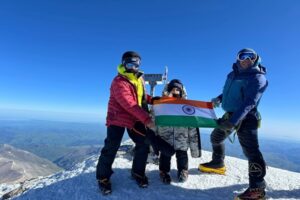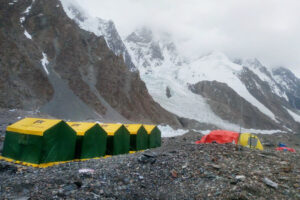Except for some hard-working Sherpas, no one has spent more time at high altitude this year than UK guide Jon Gupta. He has worked non-stop for 11 months. He guided six 8,000’ers, Pobeda Peak, and Ama Dablam. Gupta has a nuanced understanding of the industry.
Finally back at home, he has decided to guide Kangchenjunga and Makalu next spring, “but then I am done with 8,000’ers,” he said. The reason for his decision is far from simple, as he explained to ExplorersWeb.
Dream job for a mountain guide?
It seems surprising for a 35-year-old guide to step back from an obviously successful career in the Himalaya.
Since 2018, when he helped Steven Plain to achieve his record goal of climbing the Seven Summits in under four months, Jon Gupta has been one of the very few guides who work on a 1:1 client ratio.
This year, Gupta guided Rebecca Ferris on Ama Dablam in fall 2020 and K2 in summer 2021. “But then plans grew, mountain goals started piling up and we ended up climbing all we could throughout the year,” he recalls.

At 8,611m on the summit of K2 on a gorgeous day. Photo: Jon Gupta
Overall, the pair had good luck. They were among the first climbers to summit Everest and then Lhotse on the following day. They avoid the COVID outbreak in Base Camp and the two cyclones that hit the region immediately after.
One of these cyclones did hit them at Makalu BC, leading to their only failed summit of the season. After that, they succeeded on K2, likewise dodging difficulties that aborted most expeditions. On both Everest/Lhotse and K2, Gupta shared logistics with Garrett Madison’s powerful team. Madison somehow managed to get a Sherpa team to Pakistan at the very last moment.
Gupta said that the combined Sherpa force (and four Pakistani HAPs) of Madison and Pioneer Expeditions paved the way for a smooth summit push in “perfect conditions”. They decided to skip Broad Peak, although they had a permit. This fortunate decision meant that they didn’t get involved in the nightmarish –- and still very unclear –- summit push and botched rescue. Here, Korean climber Kim HongBin perished and Qatar’s Fahad Badar lost all the fingers of his right hand to frostbite.
Next came Manaslu –- relatively easy, crowded, and culminating in the “summit” — in fact, a foresummit. Then Dhaulagiri and finally Ama Dablam, which he topped out for the 13th and perhaps final time.
New Year’s resolutions
Of course, the long months away from home have taken their toll. “I miss my family, my friends…the weddings! My best friend got married this past summer and I was not there,” he said. “I am becoming the eternal single because no one wants to go out with you if you are never there.”
But that is only part of his reason for quitting. Gupta is not exactly swapping the Himalaya for gardening. After Makalu, he’ll apply to enter the IFMGA guide program. If accepted, he’ll spend the next four years almost fully engaged in acquiring that certification.
“It’s not like I’m hanging up my crampons,” he said. “I want to keep guiding and climbing other things: in places such as Mt. Kenya, the Andes, the Alps… and I want to climb with friends on more technical routes.
“I read about the teams on Saraghrar and Annapurna III –- climbs like this are what really inspire me,” he admits. Such climbs are totally different from jumar-only ascents.
Of course, jumars, ropes, and crowds are no surprise to him. He has been on Everest four times and guided intensely for a decade. It’s something else.

Jon Gupta on K2. Photo: Jon Gupta
A dangerous spiral
“There’s been a shift in the commercial expedition world in the last few years, accelerated by COVID and possibly the Nims phenomenon, mainly consisting of the explosive growth of Nepal-based companies,” Gupta said. “Western guides are not as present as they were before.”
The problem is not who owns the company, but the kind of clients they attract and the resources that some guides have. “Outfitters are multiplying so fast and fighting for a piece of the market,” said Gupta. “In order to make it, they accept virtually everyone. The average level of experience in clients climbing 8,000’ers has decreased noticeably.”
The number of incidents has also increased. “On Ama Dablam, people were being airlifted out almost daily,” he said.
The need for self-care
Rather than mountain accidents — mostly lethal on a technical peak like Ama Dablam — Gupta noted cases of frostbite, snowblindness, and Acute Mountain Sickness. The first two, and even arguably the third, are avoidable: They’re mainly from lack of proper self-care.
“While on 8,000’ers like Manaslu, climbers mainly take care to stay hydrated and keep their hands and feet warm while they go up the fixed ropes, Ama Dablam has difficult, steep passages that require your whole focus,” he explained. “Attention toward hydration, hypothermia, symptoms of hypoxia and general health must be automatic. Inexperienced climbers often find it hard both to take care of themselves and climb at the same time.”

Rebecca Ferris above the clouds on Manaslu, before the summit push. Photo: Jon Gupta
Some Sherpa guides are very well trained and highly skilled, says Gupta. But others have learned by experience, working for expeditions. “They only know this very specific way of climbing and fixing ropes, but lack resources if something fails or go differently from planned,” he says, adding:
“Some of these local climbers have an impressive summit resumé, but they are not as well prepared technically, about snow and weather, for example. And their clients don’t know either…if they are climbing safely or taking huge risks.
“This is a dangerous spiral because, if not dealt with carefully, the companies will keep growing, and there will be more crowding and more accidents, and Western clients will want to go to these mountains less and less.”
Gupta believes that currently, the best outfitters are still partnerships between great Sherpa teams and Western-led companies able to train any local staff who need to improve their skills.
“Finally,” says Gupta, “I can’t help feeling uncomfortable about social media and its effects on climbing. Of course, we all take pictures of sunset from Camp 2 on Ama. But the constant need to post everything on Instagram, the culture of the selfie, makes me feel strange about it all.”
Gupta will experience this again next spring on Kangchenjunga. All the major Nepali outfitters have announced teams, but Gupta expects that no more than 40 climbers will be on the mountain. “This time, I’ll be with a bigger group, which includes some very good friends who are also experienced climbers,” he says.

Will Makalu (in background) be Jon Gupta’s last 8,000’er? Photo: Jon Gupta





